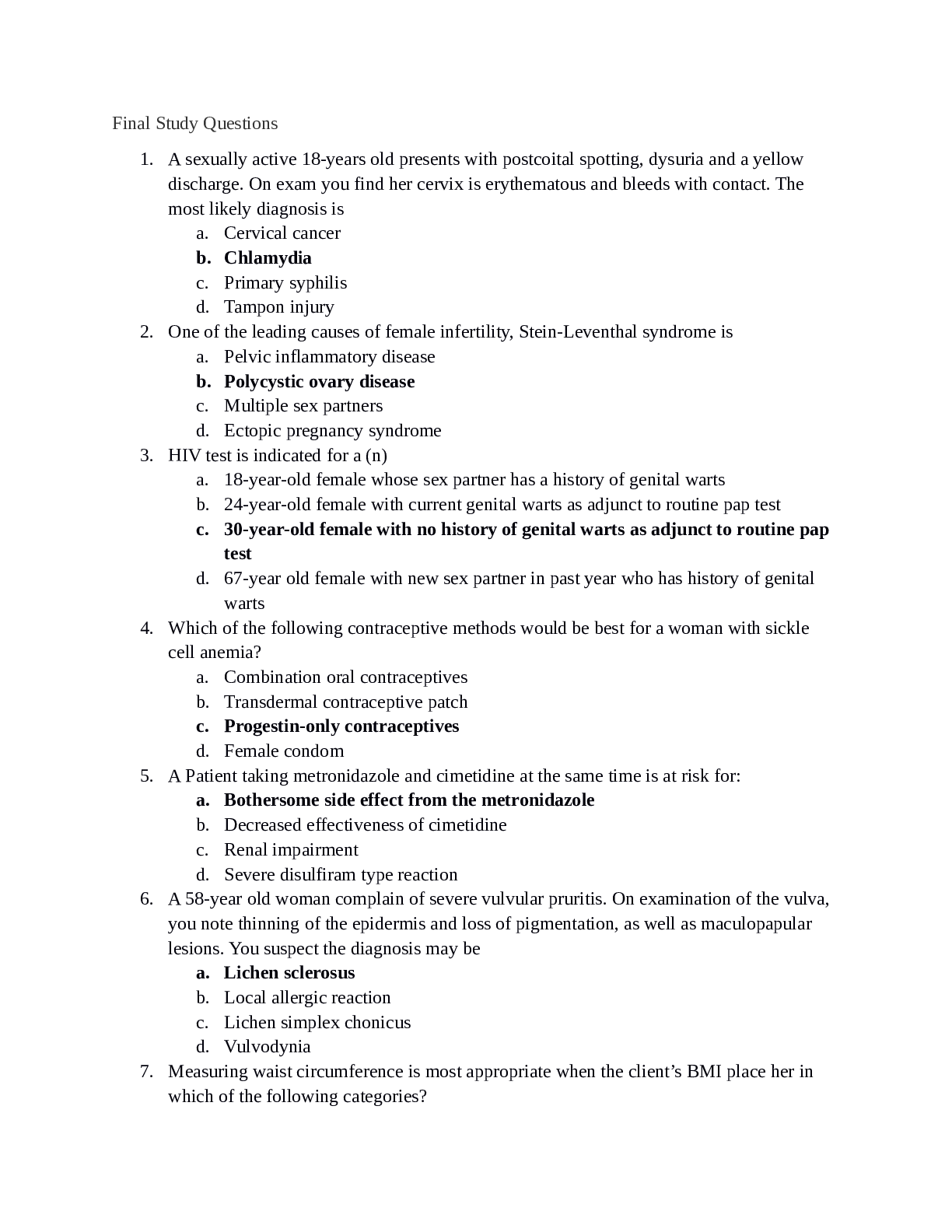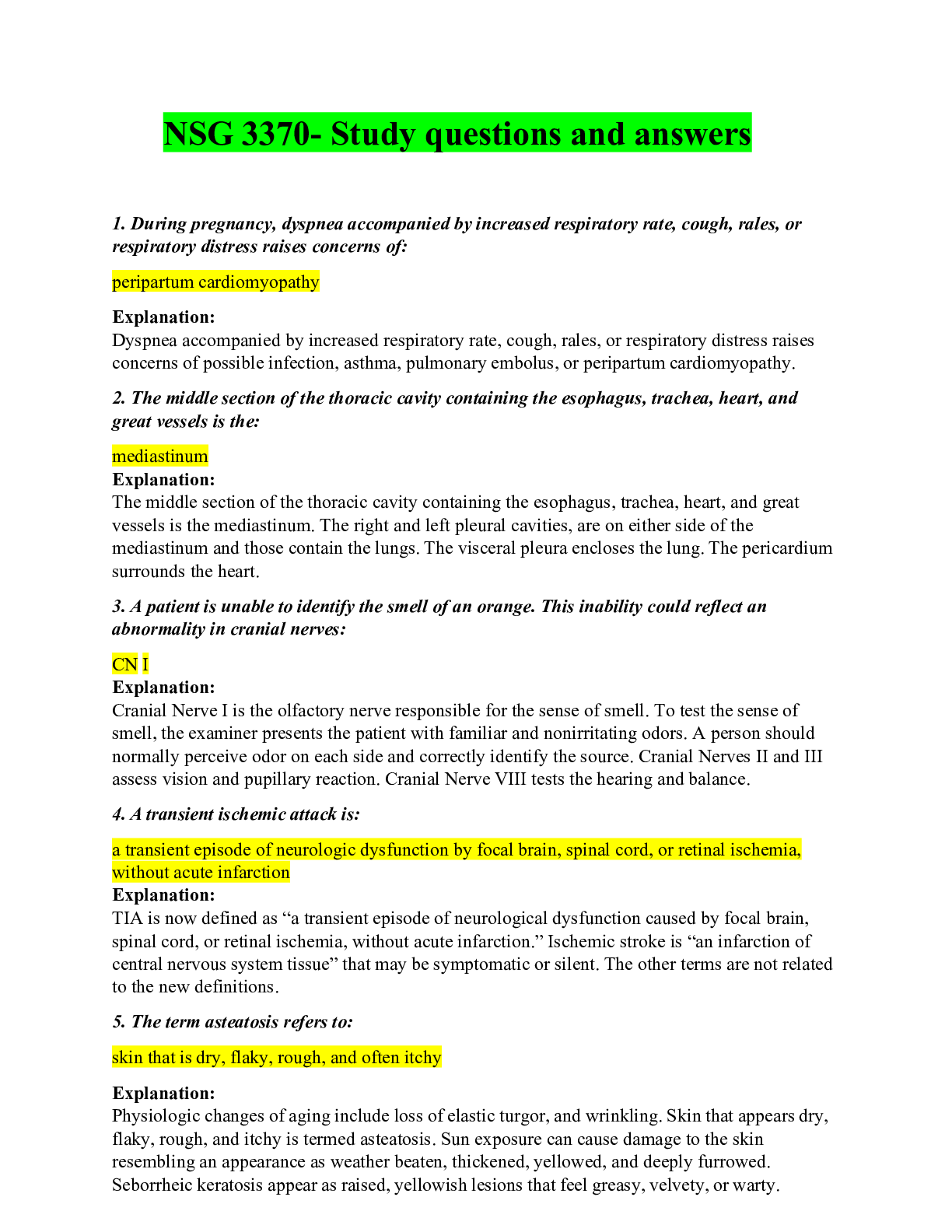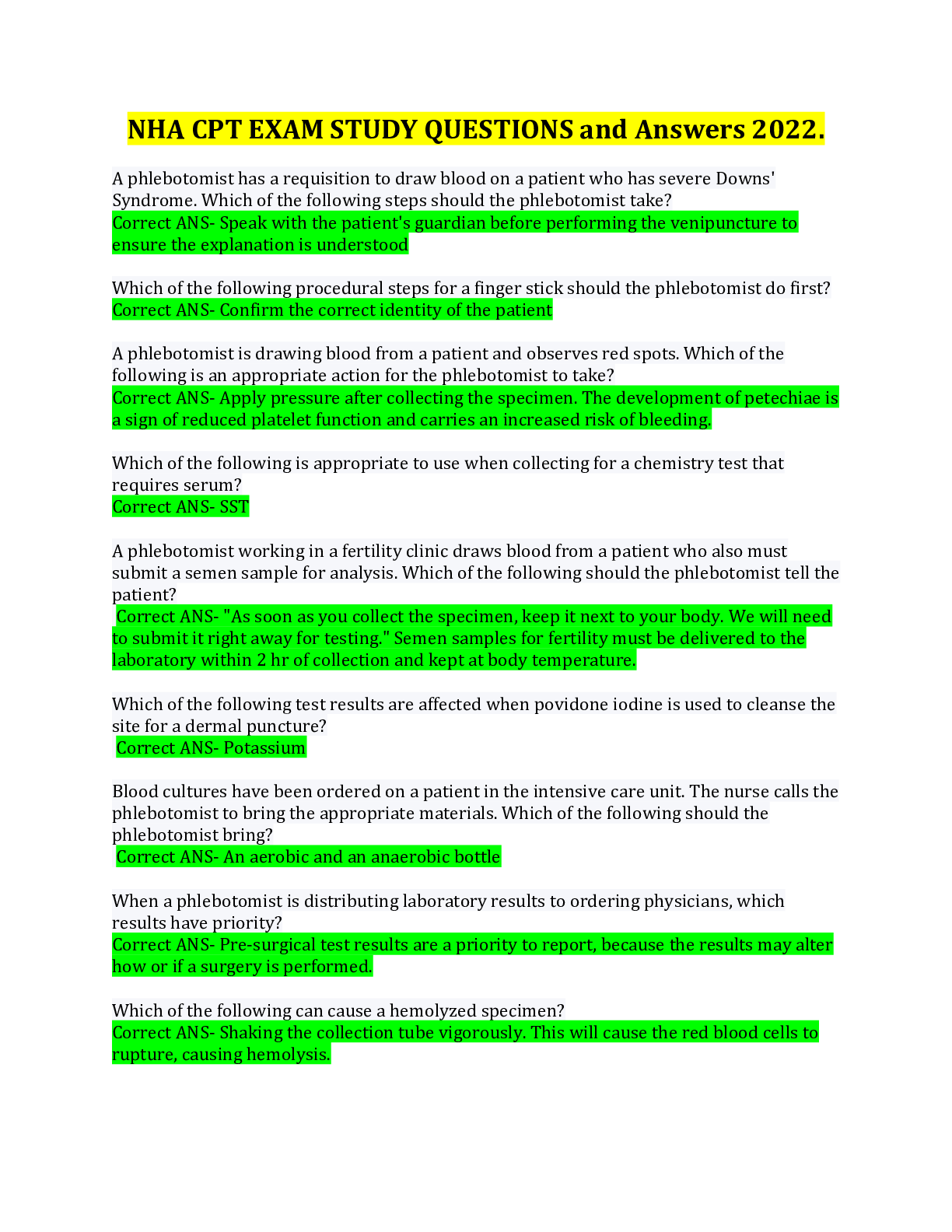*NURSING > EXAM > NSG 3370 Study Questions and Answers Mostly Studied and Asked Questions 2020 Troy University, Montgo (All)
NSG 3370 Study Questions and Answers Mostly Studied and Asked Questions 2020 Troy University, Montgomery
Document Content and Description Below
NSG 3370 Study Questions and Answers Mostly Studied and Asked Questions 2020 Troy University, Montgomery NSG 3370 Study Questions 2020 _ Troy University_Montgomery 300 Questions and answers 1. During... pregnancy, dyspnea accompanied by increased respiratory rate, cough, rales, or respiratory distress raises concerns of: peripartum cardiomyopathy Explanation: Dyspnea accompanied by increased respiratory rate, cough, rales, or respiratory distress raises concerns of possible infection, asthma, pulmonary embolus, or peripartum cardiomyopathy. 2. The middle section of the thoracic cavity containing the esophagus, trachea, heart, and great vessels is the: mediastinum Explanation: The middle section of the thoracic cavity containing the esophagus, trachea, heart, and great vessels is the mediastinum. The right and left pleural cavities, are on either side of the mediastinum and those contain the lungs. The visceral pleura encloses the lung. The pericardium surrounds the heart. 3. A patient is unable to identify the smell of an orange. This inability could reflect an abnormality in cranial nerves: CN I Explanation: Cranial Nerve I is the olfactory nerve responsible for the sense of smell. To test the sense of smell, the examiner presents the patient with familiar and nonirritating odors. A person should normally perceive odor on each side and correctly identify the source. Cranial Nerves II and III assess vision and pupillary reaction. Cranial Nerve VIII tests the hearing and balance. 4. A transient ischemic attack is: a transient episode of neurologic dysfunction by focal brain, spinal cord, or retinal ischemia, without acute infarction Explanation: TIA is now defined as “a transient episode of neurological dysfunction caused by focal brain, spinal cord, or retinal ischemia, without acute infarction.” Ischemic stroke is “an infarction of central nervous system tissue” that may be symptomatic or silent. The other terms are not related to the new definitions. 5. The term asteatosis refers to: skin that is dry, flaky, rough, and often itchy Explanation: Physiologic changes of aging include loss of elastic turgor, and wrinkling. Skin that appears dry, flaky, rough, and itchy is termed asteatosis. Sun exposure can cause damage to the skin resembling an appearance as weather beaten, thickened, yellowed, and deeply furrowed. Seborrheic keratosis appear as raised, yellowish lesions that feel greasy, velvety, or warty. Painful vesicular lesions in a dermatomal distribution may suggest herpes zoster. 6. An enlarged liver with a smooth tender edge may suggest: right-sided heart failure. Explanation: An enlarged liver with a smooth, tender edge suggests inflammation, as in hepatitis, or venous congestion, as in right-sided heart failure. Cirrhosis, hematochromatosis (increased amount of iron in the blood), and lymphoma produce an enlarged liver with a firm, nontender edge. An enlarged liver that is firm or hard and has an irregular edge or surface suggests hepatocellular carcinoma. 7. New onset hypertension with proteinuria or end-organ damage is: preeclampsia Explanation: Chronic hypertension occurs when systolic BP (SBP) >140 mm Hg or diastolic BP (DBP) >90 mm Hg documented prior to pregnancy, before 20 weeks, or beyond 12 weeks postpartum. Gestational hypertension refers to elevated blood pressure detected after 20 weeks gestation in the absence of proteinuria. Pre-eclampsia occurs in a woman who was previously normotensive but now has new onset hypertension with either proteinuria or end-organ damage. Primary hypertension, formerly known as essential hypertension, is a disorder which is associated with elevated blood pressure and an unidentifiable cause. 8. The psoas muscle group and muscles of the abdominal wall assist with: flexion Explanation: The psoas muscle group and muscles of the abdominal wall assist with flexion. The deep intrinsic muscles of the back assist with extension. The abdominal muscles and intrinsic muscles of the back assist with rotation. Lateral bending uses the abdominal muscles and intrinsic muscles of the back. 9. "Preterm small for gestational age" (SGA) infants are prone to: hypocalcemia Explanation: "Preterm appropriate for gestational age" (AGA) infants are prone to respiratory distress syndrome, apnea, patent ductus arteriosus with left-to-right shunt, and infection. "Preterm small for gestational age" (SGA) infants are more likely to experience asphyxia, hypoglycemia, and hypocalcemia. 10. Swelling noted 1-2 inches below the knee joint and on the medial surface of the knee would be suggestive of: anserine bursitis Explanation: Swelling 1-2 inches below the knee joint and on the medial surface would be suggestive of anserine bursitis. Swelling over the tibial tubercle suggests infrapatellar bursitis. Swelling over the patella suggests prepatellar bursitis. Semimembranous bursitis would be suggested by swelling on the posterior and medial surface of the knee. 11. A patient states that the only way he can sleep at night is to use several pillows or to sleep upright in a recliner. This sleep pattern is most consistent with: obstructive lung disease Explanation: With obstructive lung disease, the patient experiences orthopnea, dyspnea that occurs when the patient lies down but improves with sitting. Therefore, the patient would use several pillows or sleep upright in a recliner. Orthopnea is seen in obstructive lung disease, mitral stenosis, and heart failure. Paroxysmal nocturnal dyspnea describe episodes of sudden dyspnea that cause the patient to awaken from sleep where the patient must sit up, walk, or stand for it to resolve. Coughing and wheezing may also occur. Angina pectoris commonly creates chest pain or shortness of breath. Jugular venous pressure reflects right atrial pressure and volume status. In cases of cardiac or pulmonary dysfunction, jugular venous pressures usually raise. 12. A positive obturator sign would elicit pain in the: right hypogastric area Explanation: Assessment of the obturator sign is performed by flexing. By flexing the patient's right thigh at the hip with the knees bent, rotating the leg internally at the hip. If this causes increased pain in the right epigastric area, then the obturator sign is positive. Hypogastric pain occurs as the obturator muscle rubs an inflamed appendix. 13. The lateral bone that serves as a strut between the scapula and the sternum is known as the: clavicle Explanation: The lateral bone that serves as a strut between the scapula and the sternum is known as the clavicle. The humerus is the long bone of the upper arm. The acromion process is an extension of the spine of the scapula and located at the highest point of the shoulder. The thick curved extension of the superior border of the scapula is referred to as the coracoid process. 14. When examining the foot of a patient, the nurse practitioner notes focal heel tenderness on palpation of the plantar fascia. This could be suggestive of: plantar fasciitis Explanation: Focal heel tenderness on palpation of the plantar fascia suggests plantar fasciitis. Bone spurs may be present on the calcaneus as bony projections and may cause numbness, tenderness, or pain. Localized tenderness on examination of the ankle joint could be suggestive of arthritis, infection of the ankle, or ligamentous injury. Tenderness along the posterior medial malleolus suggests posterior tibial tendinitis. 15. When examining the conjunctiva and sclera, have the patient look upward and then: depress both lower lids with your thumbs, exposing the sclera and conjunctiva Explanation: When examining the conjunctiva and the sclera, the best way to expose these structures is to have the patient look upward and depress both lower lids with your thumbs. Covering one eye while visualizing the other eyes checks for visual acuity. Observing for excessive tearing or dryness assesses the lacrimal apparatus. Checking the position of the lids may identify variations and abnormalities in the eyelids. 16. The groove of the metacarpophalangeal joint can be palpated by having the patient: flex his hand Explanation: The groove of the metacarpophalangeal joints can be palpated by having the patient flex his hand. 17. A patient complains of shooting pains below the knee radiating into the lateral leg and calf. This type of low back pain is referred to as: radicular low back pain Explanation: Radicular low back pain, or sciatica, presents with shooting pains below the knee, into the lateral leg or posterior calf. It may be accompanied by paresthesias and/or weakness in the affected leg. Mechanical low back pain often arises from muscle and ligament injuries (~70%) or age-related intervertebral disc or facet disease. Common symptoms include aching pain in the lumbosacral area that radiates to the upper leg. Common risk factors include heavy lifting, poor conditioning, and obesity. Lumbar spinal stenosis or "pseudoclaudication" refers to pain in the back or legs with walking that improves with rest, lumbar flexion, or both. 18. When assessing a 3-month-old for developmental dysplasia of the hips (DDH), which one of the following symptoms would be suspicious of dysplasia? Limitation of abduction of the affected extremity, shortening of the femur and positive Ortolani's sign Explanation: Developmental dysplasia of the hips (DDH) presents with limitation of abduction, shortening of the extremity, as the head of the femur does not fit into the acetabulum, and a positive Ortolani's (it clicks when maneuvered). DDH presents with asymmetry of the gluteal folds. 19. A patient presents with right upper quadrant and upper abdominal pain. Acute cholecystitis is suspected because the pain radiates to the: right scapula area Explanation: Acute cholecystitis presents with right upper quadrant and upper abdominal pain - - - - - - - - - - - - - - - - - - - - - - - - - - - - - - - - - - - - - - 292. The structure that encloses the spinal cord is known as the: vertebral foramen Explanation: The vertebral foramen encloses the spinal cord. The structure that projects from the spinal column posteriorly in the midline is referred to as the spinous process. The articular processes are located on each side of the vertebra at the junction of the pedicles and the laminae, also referred to as the articular facets. 293. A multifactorial geriatric condition or syndrome characterized by an age-related lack of adaptive physiological capacity occurring in the absence of identifiable illness is known as: frailty Explanation: A multifactorial geriatric condition or syndrome characterized by an age-related lack of adaptive physiological capacity occurring in the absence of identifiable illness is known as frailty. Delirium is a serious disturbance in a person's mental abilities that results in a decreased awareness of one's environment and confused thinking. In the older adult, it is defined as a geriatric syndrome or condition occurring as a temporary state of confusion and may be the first clue to infection or problems with medications. Cognitive impairment is an intermediate stage between the expected cognitive decline of normal aging and the more serious decline of dementia. Functional impairment is a health condition in which the normal function of a part of the body is less than full capacity. One of the defining characteristics of functional impairment is that the reduction in physical or mental capacity is sufficient to interfere with managing day-to-day tasks. 294. When assessing the cranial nerves, the nurse practitioner uses the tongue blade to gently stimulate the back of the throat on each side. A unilateral absence of the gag reflex is noted. This finding could be suggestive of a unilateral lesion in which cranial nerve? Cranial Nerve IX (CN IX) Explanation: Unilateral absence of the gag reflex suggests a lesion of CN IX or CN X. glossopharyngeal and vagus nerves. 295. When performing the bimanual vaginal exam, uterine enlargement is noted. This enlargement could suggest: a malignancy Explanation: Uterine enlargement may suggest pregnancy, uterine myomas (fibroids), or malignancy. Retroversion or retroflexion of the uterus, and pelvic inflammatory disease are not typical findings with enlargement of the uterus. 296. During this type of seizure activity, the patient loses consciousness suddenly, sometimes with a cry, and the body stiffens into tonic extensor rigidity. Breathing stops, and the person becomes cyanotic. A clonic phase of rhythmic muscular contraction follows. This type of seizure activity is referred to as a: grand mal seizure Explanation: During a grand mal seizure the person loses consciousness suddenly, sometimes with a cry, and the body stiffens into tonic extensor rigidity. Breathing stops, and the person becomes cyanotic. A clonic phase of rhythmic muscular contraction follows. Focal seizures that become generalized are partial seizures that resemble tonic-clonic seizures. The patient may recall the aura and a unilateral neurologic deficit is present during the postictal period. Focal seizures with impairment of consciousness the person appears confused. Automatisms include automatic motor behaviors such as chewing, smacking the lips, walking about, and unbuttoning clothes. Tonic and then clonic movements that start unilaterally in the hand, foot, or face and spread to other body parts on the same side with the patient remaining conscious are known as Jacksonian seizures. 297. Which technique best determines whether the tissues in the chest are air-filled, fluid-filled, or solid? Percussion Explanation: Percussion of the chest produces audible sounds and palpable vibrations, thus, assisting in determining if the underlying tissues are filled with air or fluid or if they are solid. However, percussion will not help detect deep seated lesions. Auscultation assesses the flow of air through the tracheobronchial tree. Palpation focuses on tenderness and abnormalities in the overlying skin , respiratory expansion, and fremitus. Inspection notes the shape of the chest and they way it moves with inspiration and expiration. 298. Analgesia refers to: absence of pain sensation Explanation: Analgesia refers to absence of pain sensation; hypalgesia to decreased sensitivity to pain; hyperalgesia to increased sensitivity; and anesthesia to absence of touch sensation. 299. To test the anterior and lateral deltoid, pectoralis major, coracobrachialis and biceps brachii muscles, the nurse practitioner would have the patient perform which shoulder movement? Flexion Explanation: To test the anterior and lateral deltoid, pectoralis major, coracobrachialis or biceps brachii muscles, the nurse practitioner would have the patient flex his arm. 300. When comparing veins and arteries in the eyes of older adults, the arteries appear: less brilliant Explanation: In older adults, the fundi lose their youthful shine and light reflections. The arteries look narrowed, pale, straight, and less brilliant than in young or middle adults. 301. When examining the ankle and foot of a patient, the nurse practitioner instructs the patient to point the foot toward the floor. This motion assesses: ankle flexion Explanation: Having the patient point the foot toward the floor assesses ankle flexion. Having the patient point the foot toward the ceiling assesses ankle extension. Having the patient move the heel inward assesses ankle inversion. Having the patient move the heel outward assesses eversion. 302. Children presenting with congenital heart defects that result in right to left shunting would most likely exhibit which of the following symptoms? Cyanosis, decreased cardiac output, and desaturated systemic blood Explanation: Hypoplastic left heart syndrome, truncus arteriosus, and transposition of the great arteries as well as total anomalus pulmonary venous return all fall in the mixed defects category and result in a right to left shunting. The symptoms that are usually seen are cyanosis, decreased cardiac output, and desaturated systemic blood flow along with poor tissue perfusion and symptoms of heart failure: increased pressure and increased fluid volume in the heart. The other symptoms are not consistent with right to left shunting. 303. The patella rests on the: articulating surface of the femur Explanation: The patella rests on the anterior articulating surface of the femur midway between the epicondyles, embedded in the tendon of the quadriceps muscle. 304. If abdominal pain persists when the patient raises his head and shoulders, the origin of the tenderness is probably: in the abdominal wall. Explanation: Tenderness may originate in the abdominal wall. When the patient raises his head and shoulders, the pain will persist. However, if the tenderness originates from deep in the abdomen, the pain usually decreases because it is protected by the tightened muscles. With inflammation from the pleural cavity, abdominal pain and tenderness may mimic acute cholecystitis or appendicitis. This pain increases with breathing and causes chest pain. In pancreatitis, epigastric and rebound tenderness is observed but the abdominal wall is usually soft. 305. On examination of an eighteen-year-old which one of the following neurological signs would not be helpful if meningitis is suspected? Loss of the anal reflex Explanation: If meningitis is suspected, nuchal rigidity, positive Brudzinski sign, and Kernig's sign should all be assessed. If these meningeal signs are positive, meningitis is suspected. A loss of anal reflex would suggest a lesion in the S2, 3, and 4 reflex arc. Therefore, it would not be helpful with the differential diagnosis. 306. Acholic stools are associated with: obstructive jaundice Explanation: Stools that are pale or clay or putty-colored are termed acholic. Acholic stools may occur briefly in viral hepatitis but are more common in obstructive jaundice. 307. Irregular brownish patches around the forehead, cheeks, nose, and jaw noted during pregnancy are: chloasma Explanation: Irregular brownish patches around the forehead, cheeks, nose, and jaw noted during pregnancy are known as chloasma (or melasma) or the "mask of pregnancy". This is considered a normal finding 308. The adductor tubbercle of the knee is located: medial surface Explanation: The adductor tubercle of the knee is located on the medial surface of the knee. 309. The anterior drawer sign is used to assess instability of the: anterior cruciate ligament (ACL) Explanation: The anterior drawer sign is used to evaluate the anterior cruciate ligament (ACL) for instability. A forward jerk showing the contours of the upper tibia is a positive anterior drawer sign suggestive of an ACL tear. 310. The calcaneus is located: under the talus Explanation: The calcaneus is located under the talus and is known as the heel bone. 311. One of the anterior thoracic landmarks is the costal angle. It is located: where the right and left costal margins form an angle where they meet at the xiphoid process Explanation: The right and left costal margins form an angle where they meet at the xiphoid process. This is the costal angle. The angle should be 90 degrees or less. However, the angle increases when the rib cage is chronically over inflated, as in emphysema. 312. To auscultate the tricuspid valve heart sounds in an adult patient, place the stethoscope: between the 3rd, 4th, 5th, and 6th intercostal spaces at the left lower sternal border Explanation: Auscultation should proceed in a logical manner over 4 general areas on the anterior chest, beginning with the patient in the supine position and using the diaphragm of the stethoscope. The aortic listening point is between the 2nd and 3rd intercostal spaces at the right upper sternal border (RUSB). The mitral listening point is near the apex of the heart between the 5th and 6th intercostal spaces in the mid clavicular line. The pulmonic listening point is located between the 2nd and 3rd intercostal spaces at the left sternal border (LUSB). The tricuspid region is between the 3rd, 4th, 5th, and 6th intercostal spaces at the left lower sternal border (LLSB). 313. The six to eight year-old school age child is able to: participate in competitive activities Explanation: By six to eight years of age, the school aged child is able to perform several of the following tasks: demonstrate nervous habits, have well established hand eye coordination, collect things, enjoy hobbies, enjoy a challenge, and prefers playing with the same sex friends. The other choices are consistent with the development of a 8-10 year-olds. 314. When assessing anal reflexes, the nurse practitioner strokes the four quadrants of the anus with a cotton swab. A loss of anal reflex is noted. This finding could be suggestive of a pathologic lesion in which segmented level of the spine? Sacral 2, 3, and 4 Explanation: Superficial (cutaneous) reflexes and their corresponding spinal segments include the following: Abdominal reflexes: upper thoracic 8, 9, 10 and lower thoracic 10, 11, 12; Plantar: lumbar 5 and sacral 1; and Anal: sacral 2, 3, 4. 315. The lower tip of the scapula is located: the seventh or eighth rib Explanation: The scapulae are located symmetrically in each hemithorax. The lower tip is usually at the seventh or eighth rib. 316. Primary dysmenorrhea results from: increased prostaglandin production during the luteal phase of the menstrual cycle Explanation: Dysmenorrhea is defined as pain with menses. The causes can be either primary or secondary. Primary dysmenorrhea occurs without an organic cause whereas with secondary dysmenorrhea, there is an organic cause. Primary dysmenorrhea results from increased prostaglandin production during the luteal phase of the menstrual cycle, when estrogen and progesterone levels decline. Causes of secondary dysmenorrhea include endometriosis, adenomyosis (endometriosis in the muscular layers of the uterus), pelvic inflammatory disease, and endometrial polyps. 316. proficient [Show More]
Last updated: 1 year ago
Preview 1 out of 71 pages
Instant download

Instant download
Reviews( 0 )
Document information
Connected school, study & course
About the document
Uploaded On
Dec 23, 2020
Number of pages
71
Written in
Additional information
This document has been written for:
Uploaded
Dec 23, 2020
Downloads
0
Views
39

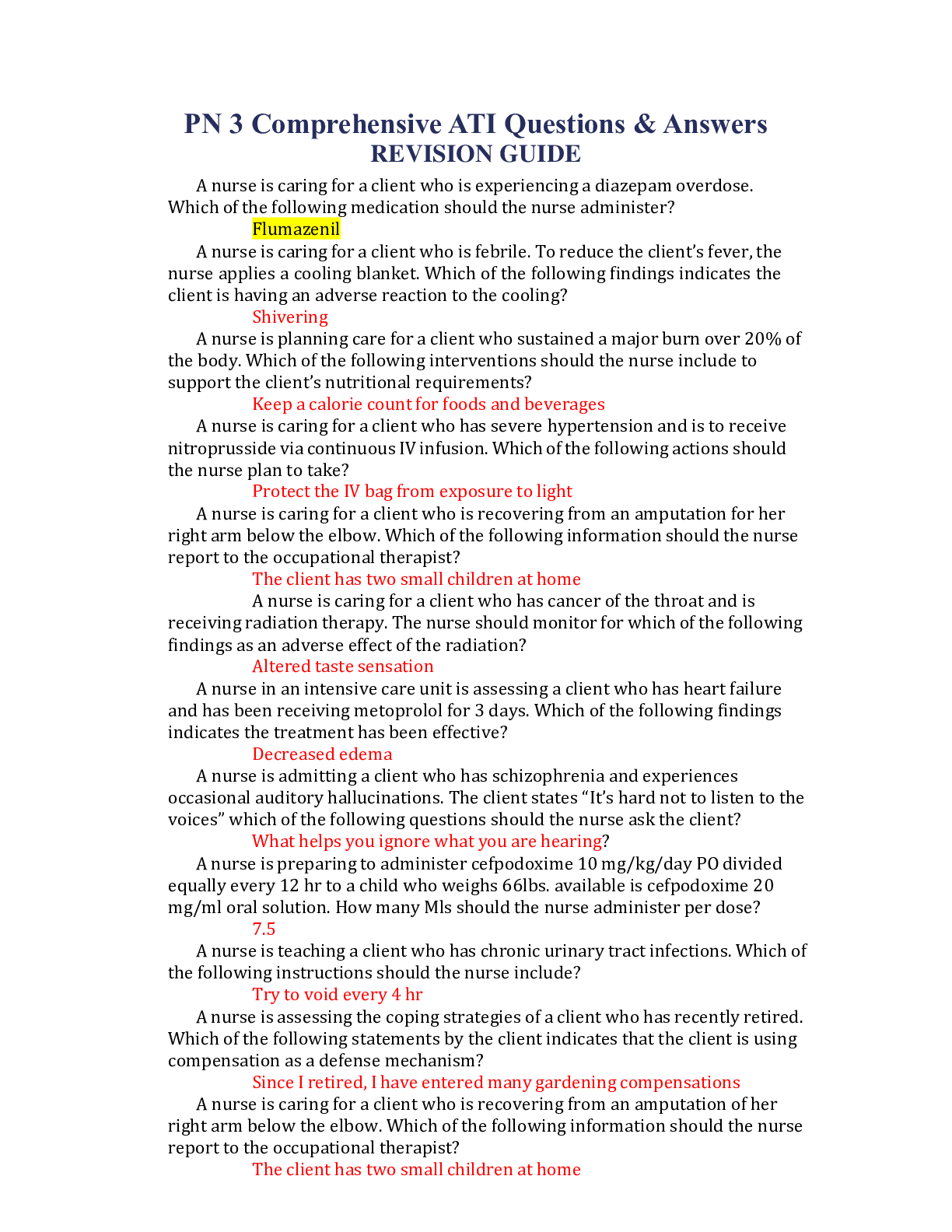
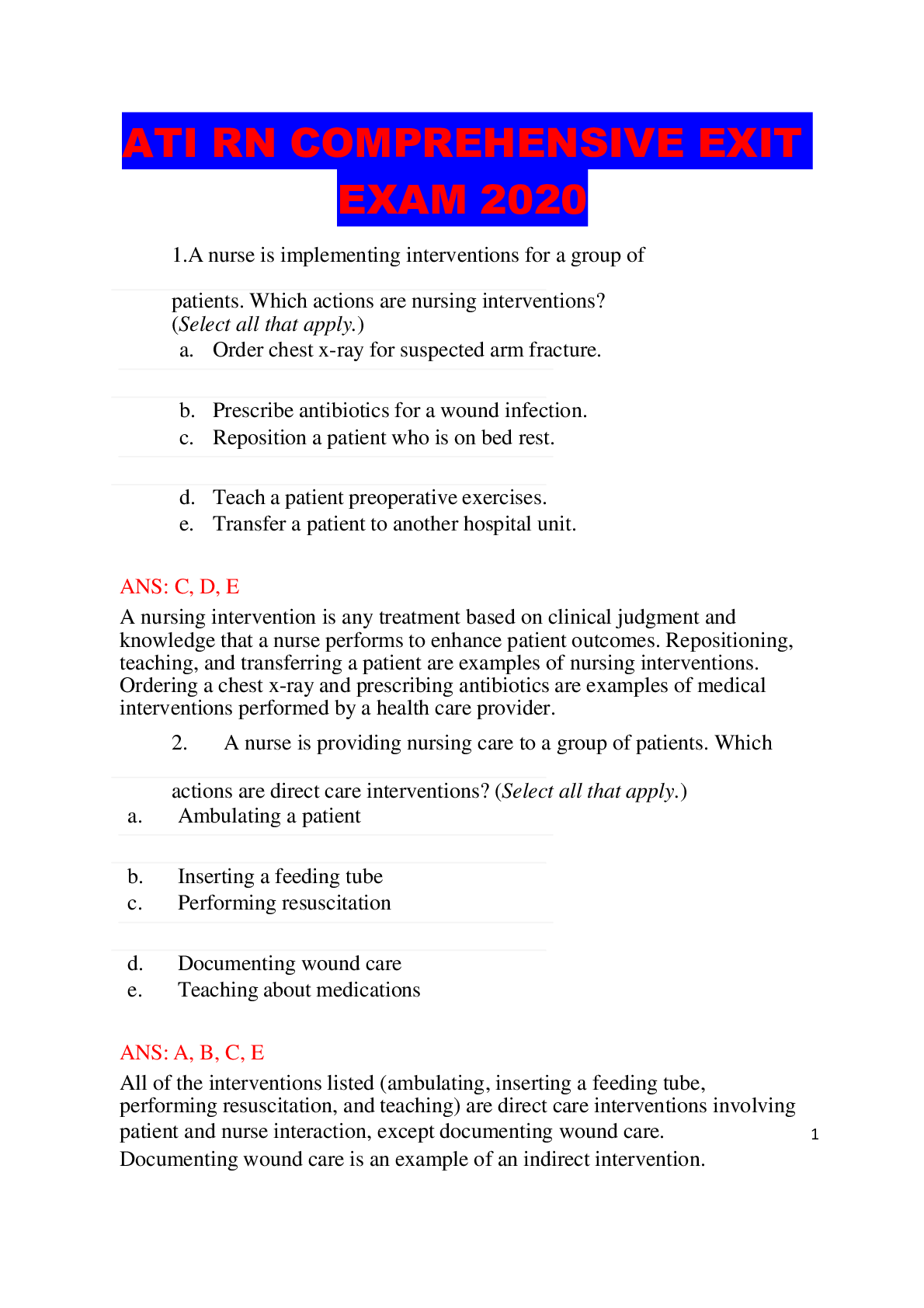



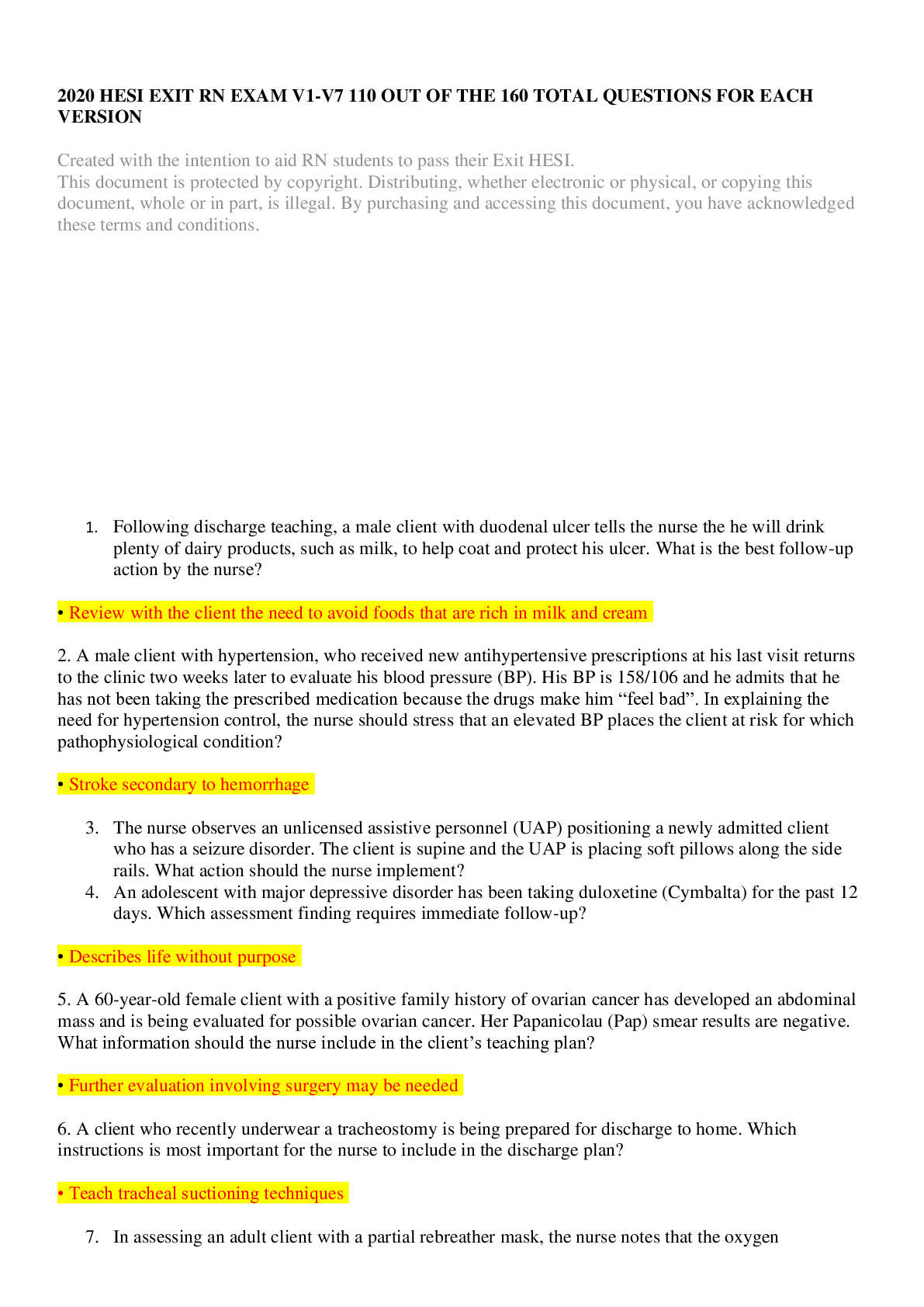
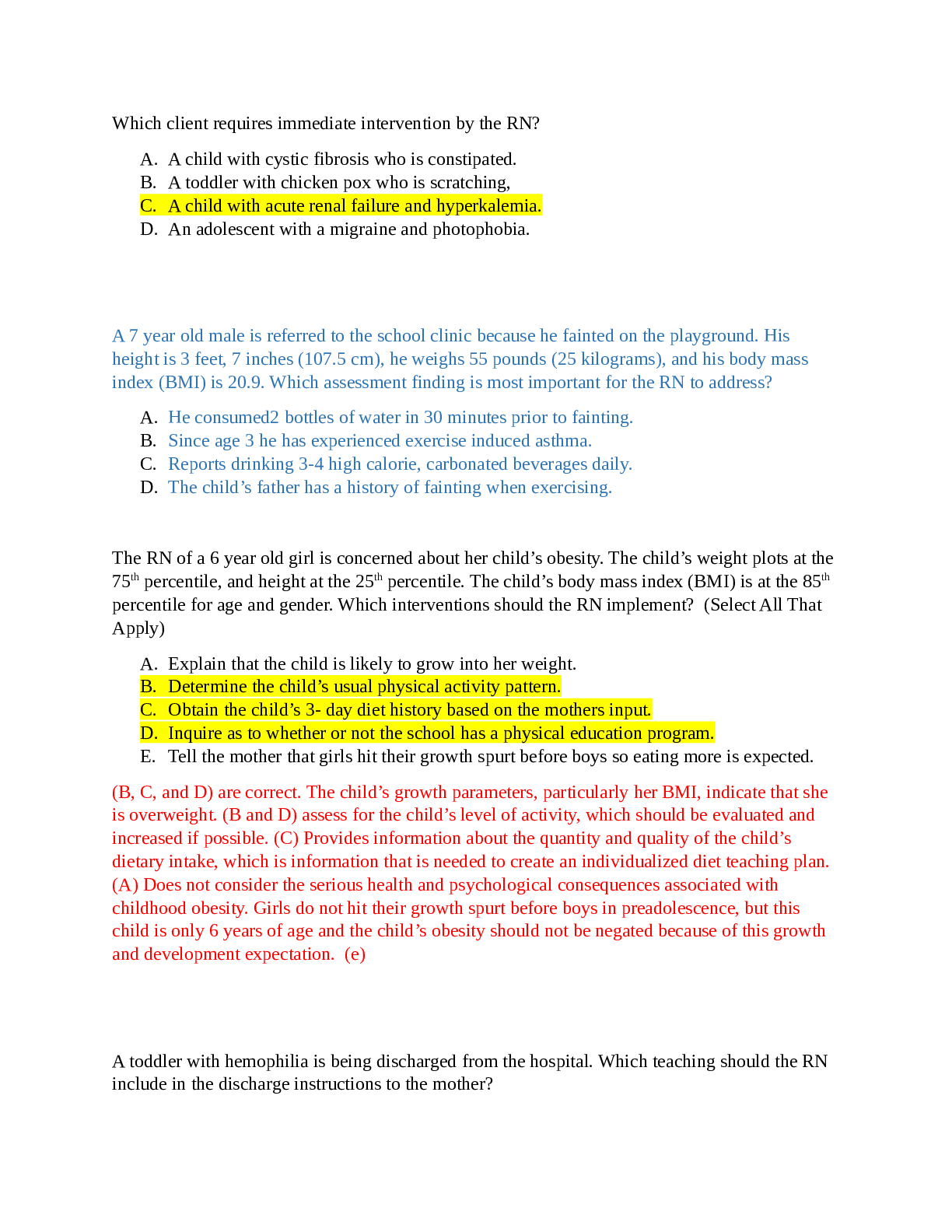

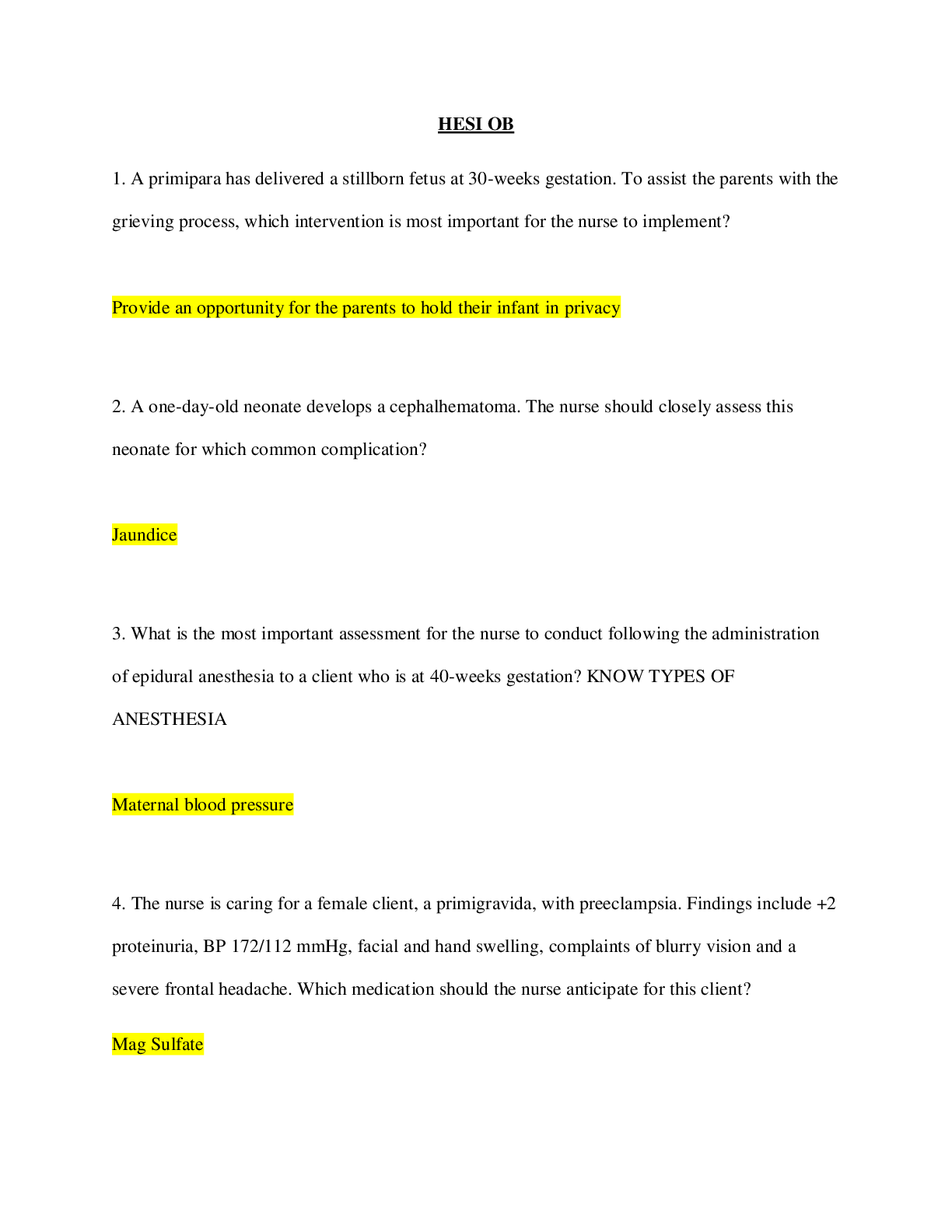
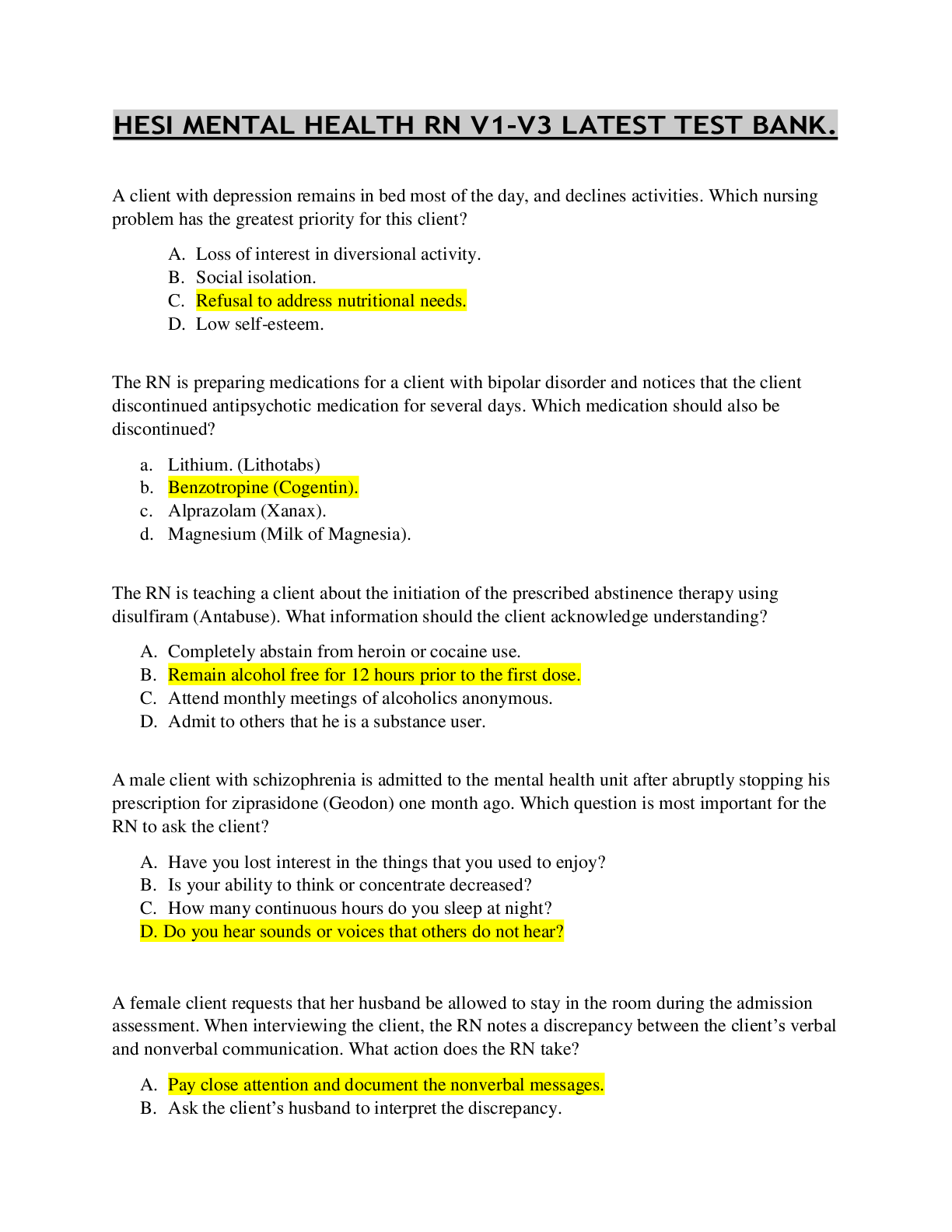







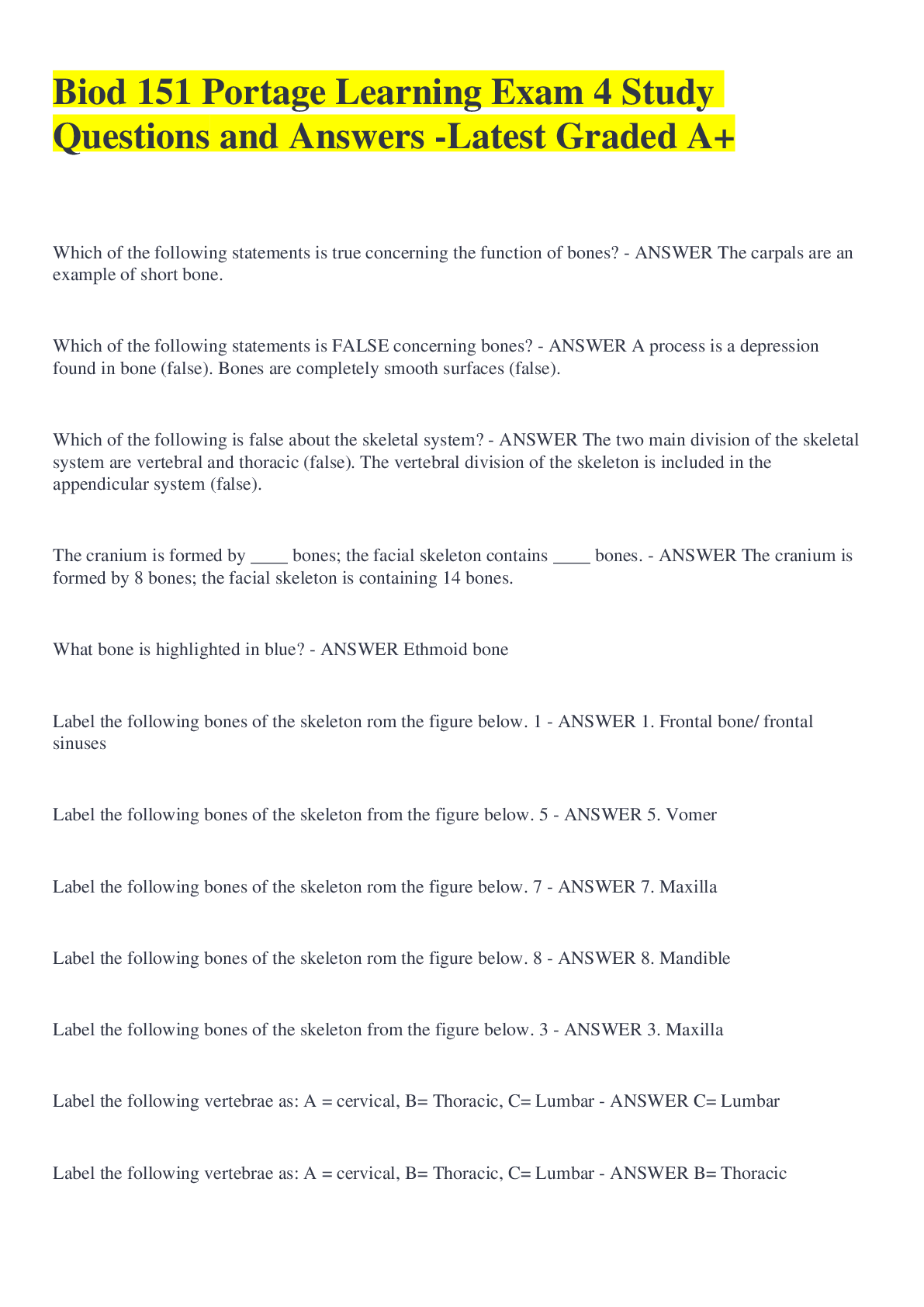
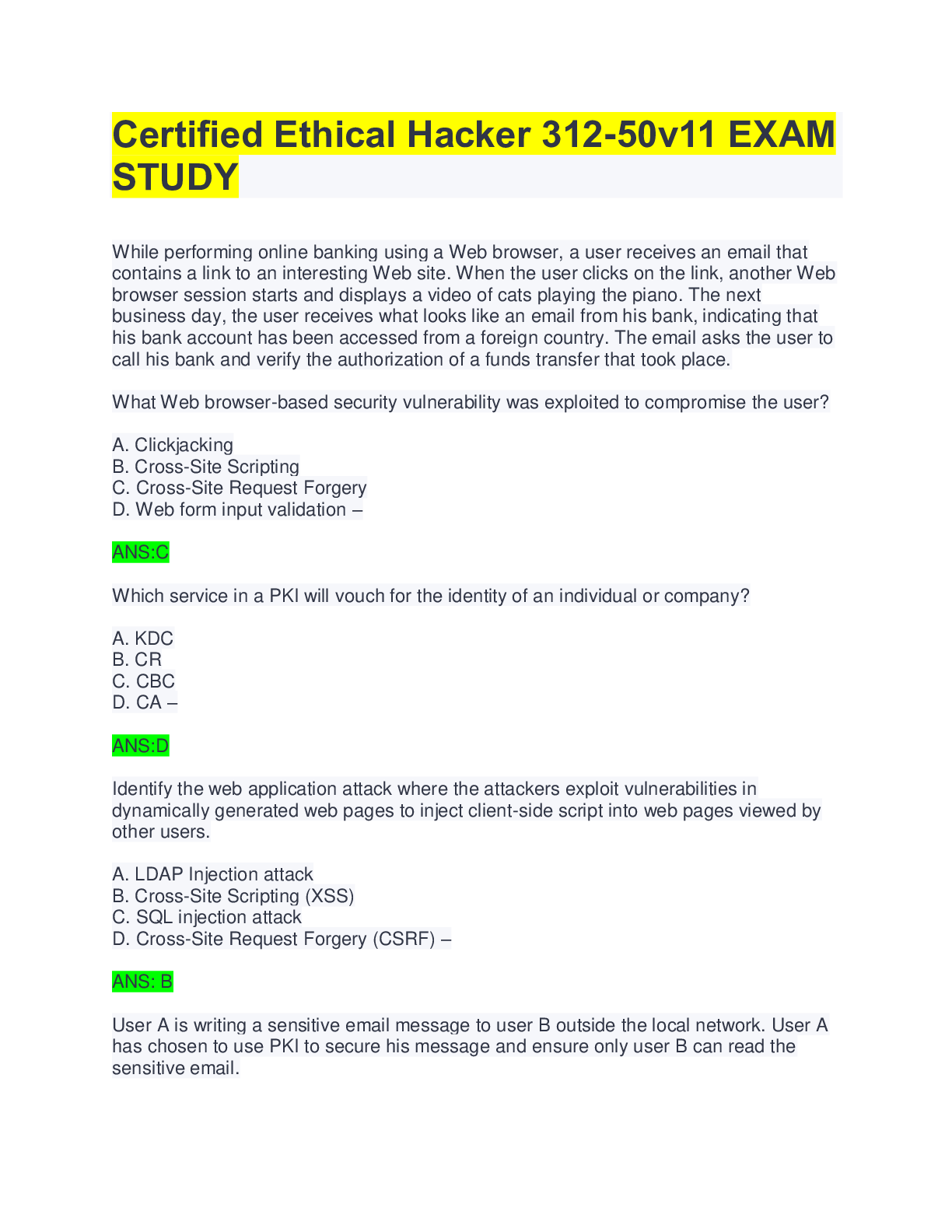
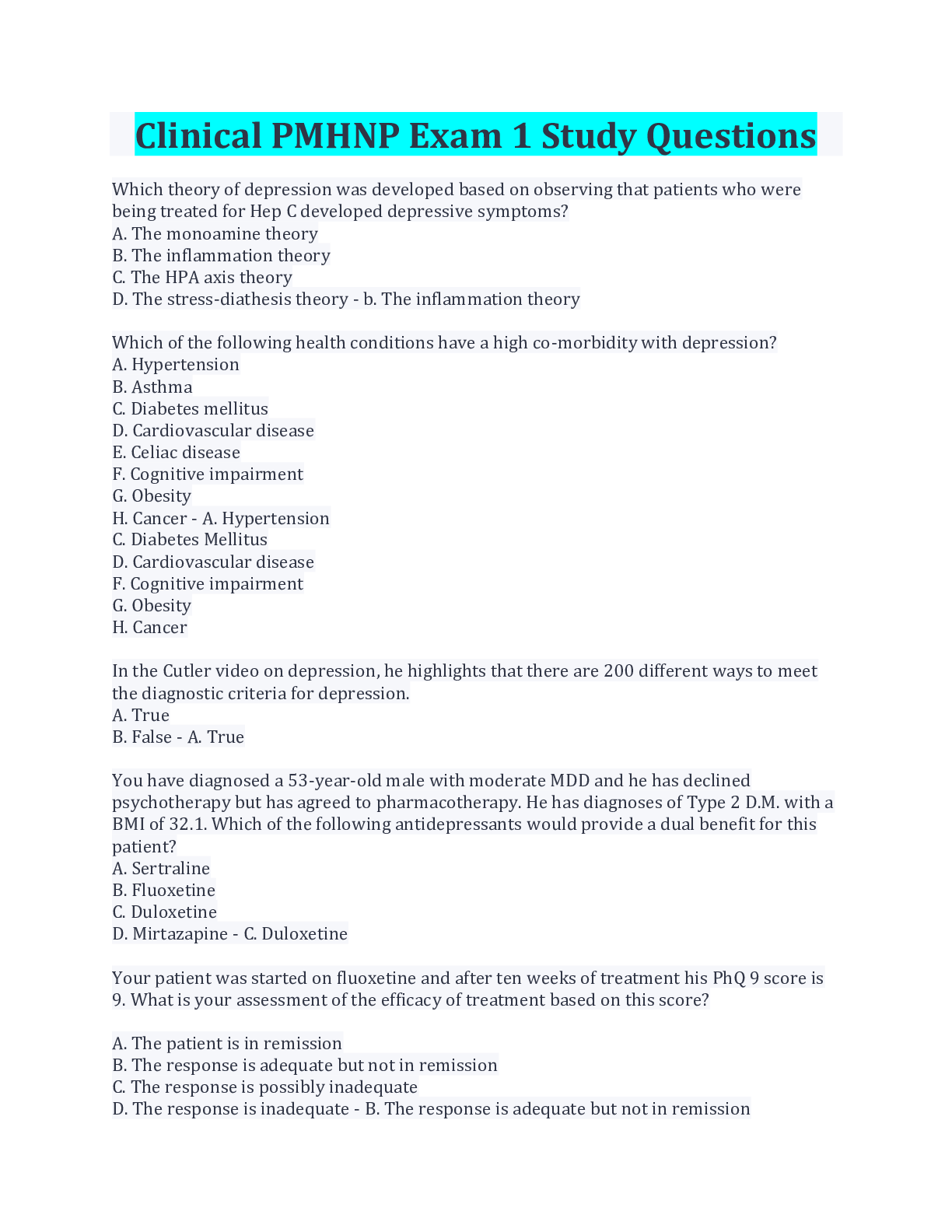
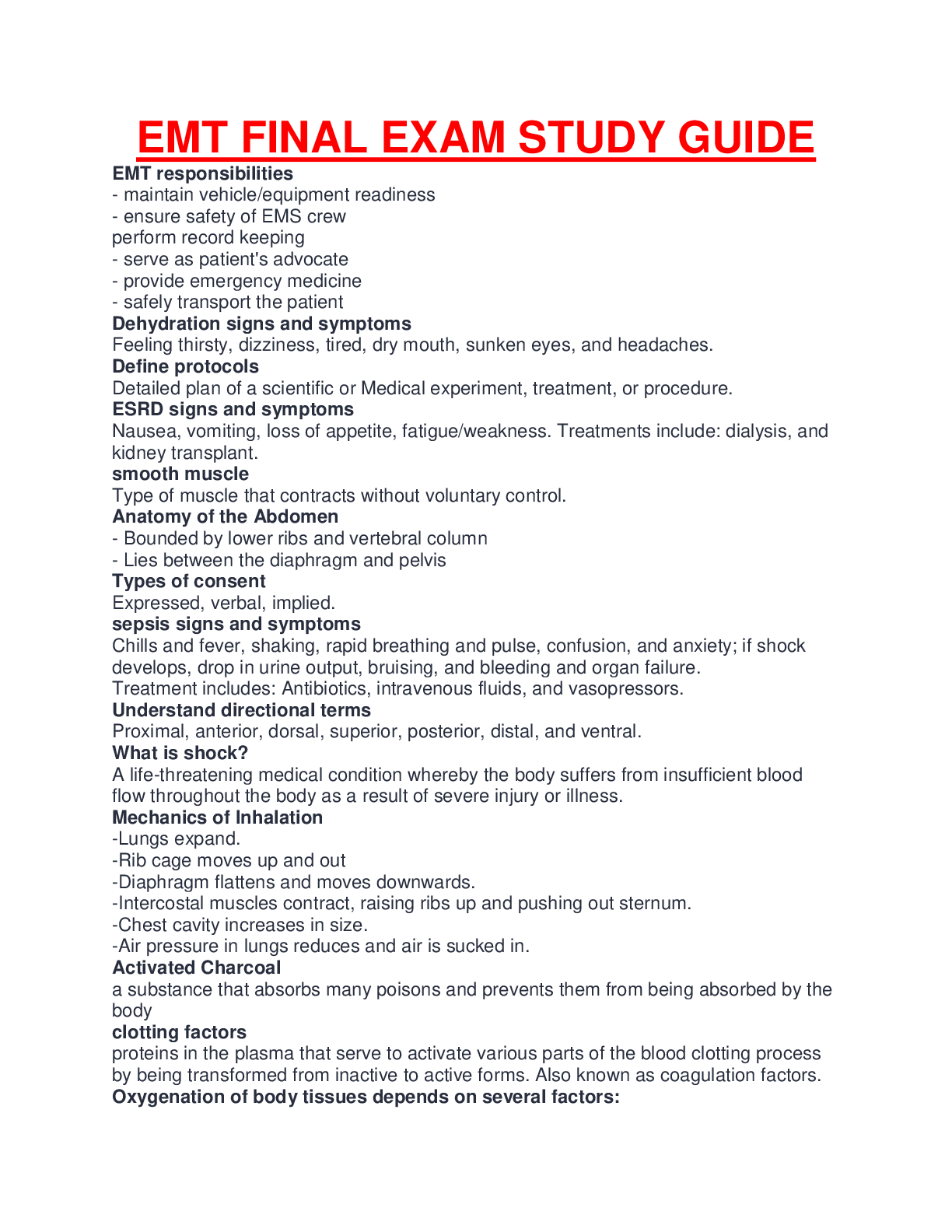
.png)
